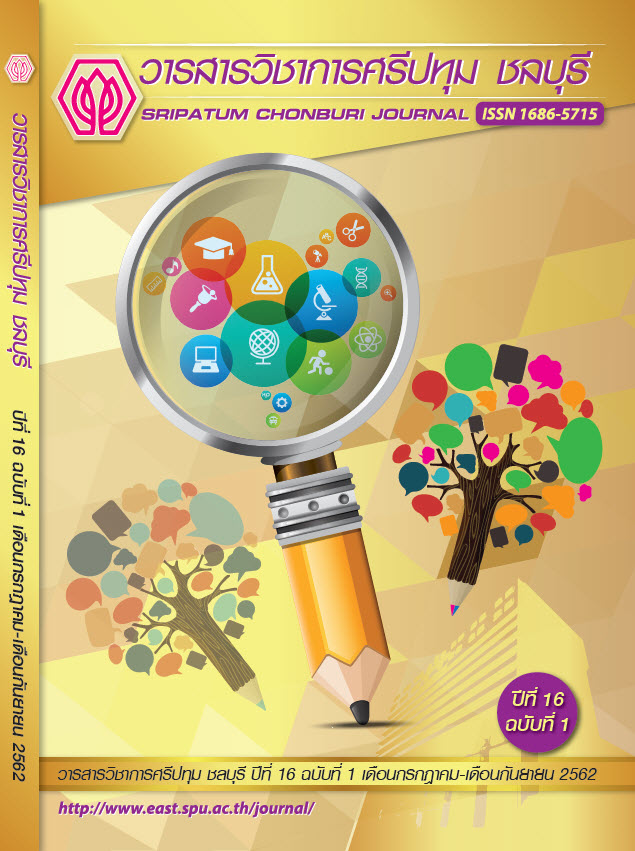THE INFLUENCE OF GENDER AND PERSONALITY DIFFERENCES ON DOMINANCE EMOTIONAL DIGITIZED SOUNDS IN YONG ADULTS: AN EVENT-RELATED POTENTIAL STUDY
Keywords:
emotional dominance, digitized sounds, event-related potentialAbstract
The purposes of this research were to studied emotional dominance in brainwaves as the articipants listened to digitized sounds on emotional dominance, classified by gender and personality. Paticipants were 80 undergraduate students, academic year 2017, Burapha University. The instruments consisted of emotional dominance digitized sounds tasks and the NeuroScan system. Data were analyzed using the Two-way analysis of variance. The results showed that:
Young adults’ brainwaves between extravert and ambivert personality as listened to digitized sounds on emotional dominance; uncontrol and control was different at frontal lobe: F7 parietal lobe: PZ P7 P4 and central lobe: CZ (p<.05). Brainwaves between male and female was different at frontal lobe: F7 and central lobe: CZ at the .05 level.
It may be concluded that young adults with different gender and personality as listened to digitized sounds on emotional dominance the brain waves were different.
References
Bastos-Filho, Teodiano Freire, et al. (2012). Evaluation of feature extraction techniques in emotional
state recognition (Online). Available: https://www.researchgate.net/publication/261044521_
Evaluation_of_Feature_Extraction_Techniques_in_Emotional_State_Recognition [2017, January 1].
Bradley, M. M., & Lang, P. J. (1999). International affective digitized sounds (IADS): Stimuli,
instruction manual and affective ratings (Tech. Rep. No. B-2). Gainesville, FL: The Center for Research in Psychophysiology, University of Florida.
Edmonds, W. A., & Kennedy, T. D. (2017). An applied reference guide to research designs: Quantitative, qualitative, and mixed methods (2nd ed.). Thousand Oaks, CA: SAGE.
Gerdes, A. B., et al. (2013). Emotional sounds modulate early neural processing of emotional Pictures (Online). Available: https://www.frontiersin.org/articles/10.3389/fpsyg.2013.00741/full [2017, January 1].
Goncalves, A. R., et al. (2018). Emotion identification and aging: Behavioral and neural age-related
changes. Clin Neurophysiol, 129(5), pp. 1020-1029.
Lang, P. J., Bradley, M. M., & Cuthbert, B. N. (1997). International Affective Picture System (IAPS): Technical manual and affective ratings (Online). Available: https://www2.unifesp.br/dpsicobio/adap/instructions.pdf [2017, January 1].
Roslan, Nur Syahirah, et al. (2017). Review of EEG and ERP studies of extraversion personality for
baseline and cognitive tasks. Personality and Individual Differences, 119, pp. 323-332.
Soares, A. P., et al. (2013). Affective auditory stimuli: Adaptation of the International Affective
Digitized Sounds (IADS-2) for European Portuguese (Online). Available:
https://link.springer.com/article/10.3758%2Fs13428-012-0310-1 [2017, January 1].
Stevenson, R. A., & James, T. W. (2008). Affective auditory stimuli: Characterization of the International Affective Digitized Sounds (IADS) by discrete emotional categories. Behavior Research Methods, 40(1), pp. 315-321.
Whittle, S., et al. (2011). Sex differences in the neural correlates of emotion: evidence from neuroimaging. Biol Psychol, 87(3), pp. 319-333.
Wildgruber, D., et al. (2009). A cerebral network model of speech prosody comprehension.
International Journal of Speech-Language Pathology, 11(4), pp. 277-281.
Downloads
Published
Issue
Section
License
บทความทุกบทความเป็นลิขสิทธิ์ของวารสารวิชาการศรีปทุม ชลบุรี



